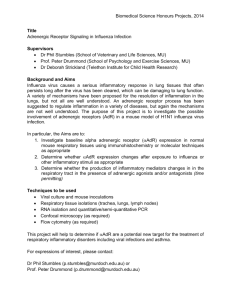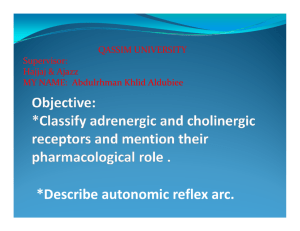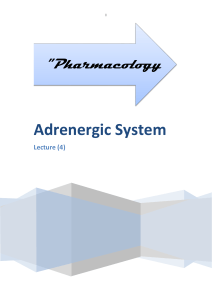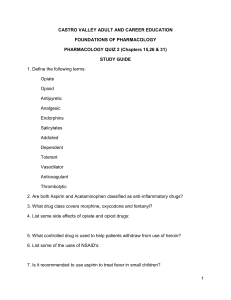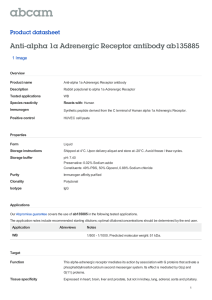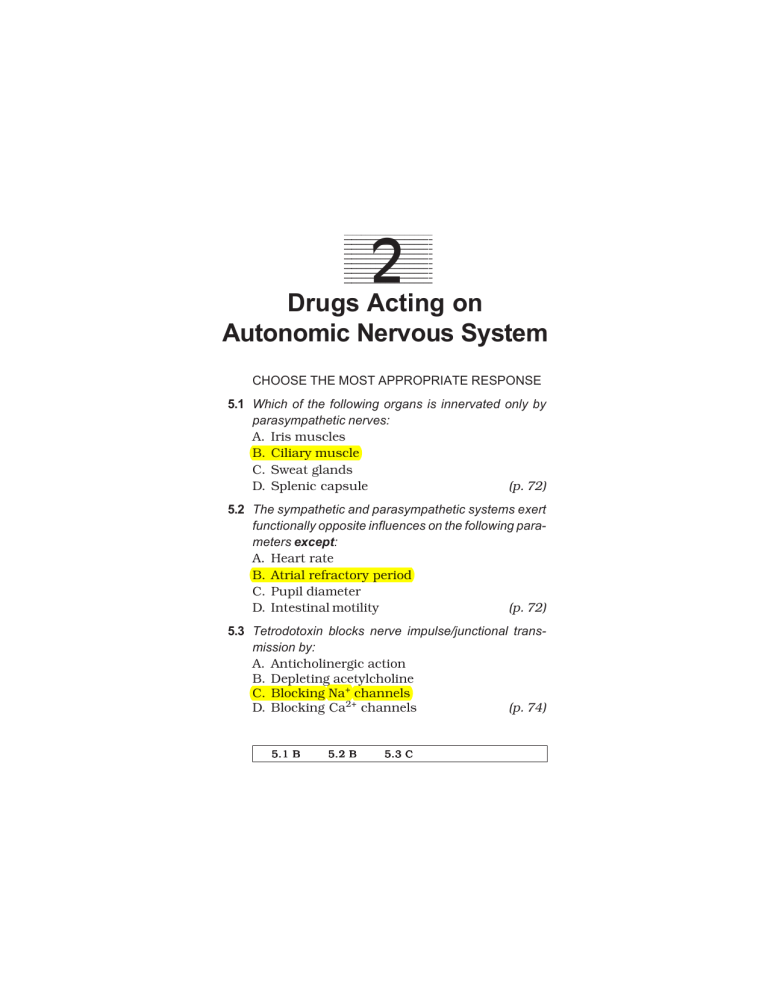
30 MCQs in Pharmacology 2 1234567890123456789 1234567890123456789 1234567890123456789 1234567890123456789 1234567890123456789 1234567890123456789 1234567890123456789 1234567890123456789 1234567890123456789 1234567890123456789 1234567890123456789 Drugs Acting on Autonomic Nervous System CHOOSE THE MOST APPROPRIATE RESPONSE 5.1 Which of the following organs is innervated only by parasympathetic nerves: A. Iris muscles B. Ciliary muscle C. Sweat glands D. Splenic capsule (p. 72) 5.2 The sympathetic and parasympathetic systems exert functionally opposite influences on the following parameters except: A. Heart rate B. Atrial refractory period C. Pupil diameter D. Intestinal motility (p. 72) 5.3 Tetrodotoxin blocks nerve impulse/junctional transmission by: A. Anticholinergic action B. Depleting acetylcholine C. Blocking Na+ channels D. Blocking Ca2+ channels (p. 74) 5.1 B 5.2 B 5.3 C Autonomic Nervous System 31 5.4 The cotransmitter may serve the following function/ functions: A. Regulate the release of the primary transmitter from the nerve ending B. Alter postjunctional action of the primary transmitter C. Itself act as an alternative transmitter D. All of the above (p. 75) 5.5 The following cotransmitter is most probably involved in mediating nonadrenergic noncholinergic (NANC) relaxation of the gut: A. Neuropeptide Y (NPY) B. Adenosine C. Nitric oxide (NO) D. Kallidin (p. 75, 603) 6.1 The major postjunctional cholinergic receptor is of the muscarinic type at the following site: A. Postganglionic parasympathetic B. Adrenal medulla C. Autonomic ganglia (p. 77) D. Neuromuscular junction 6.2 Pseudocholinesterase differs from true cholinesterase in that: A. It does not hydrolyse acetylcholine B. It hydrolyses acetylcholine at a slower rate C. It is more susceptible to inhibition by physostigmine D. It is the only form of circulating cholinesterase (p. 78) 6.3 The choline ester resistant to both true and pseudocholinesterase is: A. Methacholine B. Bethanechol C. Benzoylcholine D. Butyrylcholine (p. 78, 80) 5.4D 5.5C 6.1 A 6.2B 6.3B 32 MCQs in Pharmacology 6.4 Muscarinic cholinergic receptors: A. Are located only on parasympathetically innervated effector cells B. Mediate responses by opening an intrinsic Na+ ion channel C. Are present on vascular endothelium which has no cholinergic nerve supply D. Predominate in the autonomic ganglia (p. 77, 78) 6.5 The cardiac muscarinic receptors: A. Are of the M1 subtype B. Are of the M2 subtype C. Are selectively blocked by pirenzepine D. Function through the PIP2 → IP3/DAG pathway (p. 78) 6.6 Cholinergic muscarinic receptor stimulation produces the following effects except: A. Sweating B. Rise in blood pressure C. Bradycardia (p. 80) D. Urination 6.7 The smooth muscle structure that is relaxed by cholinergic drugs is: A. Colon B. Gastric fundus C. Major bronchi D. Bladder trigone (p. 80) 6.8 Which of the following secretions is not stimulated by acetylcholine: A. Tear B. Bile C. Pancreatic juice D. Sweat (p. 80) 6.4 C 6.5 B 6.6 B 6.7 D 6.8 B Autonomic Nervous System 33 6.9 Acetylcholine has no therapeutic application because: A. None of its actions are beneficial in any condition B. Its effects are transient C. It produces wide spread actions affecting many organs D. Both ‘B’ and ‘C’ are correct (p. 80) 6.10 Pilocarpine is used for: A. Glaucoma B. Paralytic ileus C. Urinary retention D. All of the above (p. 81) 6.11 Actions of pilocarpine include the following except: A. Sweating B. Salivation C. Miosis (p. 81) D. Cycloplegia 6.12 The following inhibitor binds only to the ani-onic site of the cholinesterase enzyme: A. Neostigmine B. Physostigmine C. Edrophonium (p. 83) D. Dyflos 6.13 Reactivation of cholinesterase enzyme occurs on hydrolysis of the inhibitor by the same enzyme molecule in case of the following anticholinesterase: A. Edrophonium B. Neostigmine C. Dyflos D. Tacrine (p. 83) 6.9 D 6.10 A 6.11 D 6.12 C 6.13 B 34 MCQs in Pharmacology 6.14 The anticholinesterase action of edrophonium is short lasting because termination of its action depends on: A. Dissociation and diffusion of the drug from the enzyme B. Hydrolysis of the drug by the enzyme C. Synthesis of fresh enzyme molecules D. A combination of the above three processes (p. 83) 6.15 The organophosphates produce irreversible inhibition of cholinesterase because: A. They bind to an allosteric site of the enzyme resulting in unfavourable conformation of esteratic site to bind acetylcholine B. Regeneration time of the phosphorylated enzyme is longer than the turnover time of the enzyme molecules C. Phosphorylation results in rapid degradation of enzyme molecules D. They are neither metabolized nor excreted from the body (p. 83) 6.16 Out of two anticholinesterases, drug ‘X’ is a tertiary amine while drug ‘Y’ is a quarternary ammonium compound. Then: A. Drug ‘X’ is likely to be more potent than ‘Y’ B. Drug ‘X’ will be more suitable to be used as a miotic C. Drug ‘Y’ will be completely metabolized in the body (p. 84) D. Drug ‘Y’ will produce CNS effects 6.14 A 6.15 B 6.16 B Autonomic Nervous System 35 6.17 Neostigmine is preferred over physostigmine for treating myasthenia gravis because: A. It is better absorbed orally B. It has longer duration of action C. It has additional direct agonistic action on nicotinic receptors at the muscle end plate D. It penetrates blood-brain barrier (p. 84, 89) 6.18 The mechanism by which neostigmine improves contraction of myasthenic muscle involves: A. Repetitive binding of the acetylcholine molecules to the same receptors at the muscle endplate B. Diffusion of acetylcholine released from motor nerve endings to a wider area activating neighbouring receptors C. Activation of motor end-plate receptors by neostigmine molecules themselves D. All of the above (p. 89) 6.19 Pyridostigmine differs from neostigmine in that: A. It is more potent orally B. It is longer acting C. It produces less muscarinic side effects D. It does not have any direct action on NM receptors (p. 84) 6.20 Edrophonium is more suitable for differentiating myasthenic crisis from cholinergic crisis because of its: A. Shorter duration of action B. Longer duration of action C. Direct action on muscle end-plate D. Selective inhibition of true cholinesterase (p. 84, 90) 6.17 C 6.18 D 6.19 B 6.20 A 36 MCQs in Pharmacology 6.21 Which of the following is a relatively cerebroselective anticholinesterase found to afford symptomatic improvement in Alzheimer's disease: A. Donepezil B. Gemfibrozil C. Pyridostigmine (p. 84-85, 439) D. Pyritinol 6.22 Pilocarpine reduces intraocular tension in open angle glaucoma by: A. Contracting sphincter pupillae B. Increasing tone of ciliary muscle C. Reducing aqueous formation D. Enhancing uveo-scleral outflow (p. 87) 6.23 The site of action of miotics for therapeutic effect in angle closure glaucoma is: A. Canal of Schlemm B. Ciliary body C. Ciliary muscle (p. 89) D. Sphincter pupillae muscle 6.24 Currently, the first choice drug for open angle glaucoma is: A. Miotic eye drops B. Ocular α2 adrenergic agonists C. Ocular prostaglandin analogues D. Ocular β adrenergic blockers (p. 85, 88) 6.25 Timolol eye drops are preferred over pilocarpine eye drops by glaucoma patients because: A. Timolol is more effective than pilocarpine B. Timolol acts by enhancing uveo-scleral outflow C. Timolol produces less ocular side effects D. There are no contraindications to timolol (p. 85, 86) 6.21 A 6.22 B 6.23 D 6.24 D 6.25 C Autonomic Nervous System 37 6.26 Beta adrenergic blockers lower intraocular tension by: A. Down regulating adenylyl cyclase in ciliary body through reduced activation of β2 adrenoceptors B. Constricting ciliary blood vessels C. Blocking adrenergic action on trabecular meshwork D. Reducing aqueous formation unrelated to beta adrenoceptor mediation (p. 85) 6.27 Agonistic action on which of the following adrenergic receptors located on ciliary epithelial cells reduces aqueous secretion: A. β1 receptor B. β2 receptor C. α1 receptor D. α2 receptor (p. 87, 88) 6.28 To be used as a topically applied ocular beta blocker a drug should have the following properties except: A. Strong local anaesthetic activity B. High lipophilicity C. High ocular capture D. Low systemic activity (p. 85) 6.29 Betaxolol differs from timolol in that it: A. Is a β1 selective blocker B. Is more efficacious in glaucoma C. Produces less ocular side effects D. Is longer acting (p. 87) 6.30 Select the longer acting ocular beta blocker: A. Timolol B. Betaxolol C. Cartiolol D. Levobunolol (p. 87) 6.26 A 6.27 D 6.28 A 6.29 A 6.30 D 38 MCQs in Pharmacology 6.31 The following is an α2 adrenergic agonist used as eyedrops to lower intraocular pressure: A. Brinzolamide B. Bambuterol C. Brimonidine D. Latanoprost (p. 88) 6.32 Which of the following is a prodrug of adrenaline used topically in glaucoma: A. Brimonidine B. Dipivefrine C. Phenylpropanolamine D. Dorzolamide (p. 88) 6.33 Apraclonidine is a clonidine congener which is used: A. To suppress opioid withdrawal syndrome B. To suppress menopausal syndrome C. As Analgesic D. To reduce intraocular tension (p. 88) 6.34 Dorzolamide is a: A. Topically applied ocular carbonic anhydrase inhibitor B. Second generation sulfonylurea hypoglycaemic C. Topical sulfonamide antibacterial D. Luminal amoebicide (p. 88) 6.35 Choose the correct statement about latanoprost: A. It is a PGF2α derivative used in glaucoma B. It is a selective α1 blocker used in benign hypertrophy of prostate C. It is a 5-α-reductase inhibitor used to reduce the size of enlarged prostate gland D. It is a PGE2 analogue used intravaginally for cervical priming (p. 88) 6.31 C 6.32 B 6.33 D 6.34 A 6.35 A Autonomic Nervous System 39 6.36 Select the diuretic that is most effective in acute congestive glaucoma: A. Indapamide B. Amiloride C. Mannitol D. Furosemide (p. 89) 6.37 Neostigmine is beneficial in cobra envenomation because: A. It binds to and inactivates cobra toxin B. It reverses coma due to cobra toxin C. It counteracts the cardio-depressant action of cobra toxin D. It antagonizes the paralysing action of cobra toxin (p. 91) 6.38 A suspected case of poisoning has been brought to the casualty with weakness, fainting, involuntary passage of urine and stools, profuse sweating, salivation, watering from nose and eyes. His pulse is 120/min, low volume, BP 90/60 mm Hg, respiration shallow, pupil constricted, muscles flabby with occasional fasciculations. Which is the most likely type of poisoning: A. Belladonna B. Barbiturate C. Anticholinesterase D. Dicophane (DDT) (p. 91) 6.39 Which is the most important drug in the treatment of organophosphate poisoning: A. Atropine sulfate B. Pralidoxime C. Diazepam D. Adrenaline (p. 91) 6.36 C 6.37 D 6.38 C 6.39 A 40 MCQs in Pharmacology 6.40 Atropine does not antagonise the following feature of anticholinesterase poisoning: A. Hypotension B. Central excitation C. Muscle paralysis (p. 91) D. Bronchoconstriction 6.41 Pralidoxime can reactivate cholinesterase enzyme that has been inactivated by: A. Carbamate anticholinesterases B. Organophosphate anticholinesterases C. Both carbamate and organophosphate anticholinesterases (p. 91-92) D. Reversible anticholinesterases 7.1 Initial bradycardia caused by intramuscular injection of atropine is believed to be caused by: A. Stimulation of medullary vagal centre B. Stimulation of vagal ganglia C. Blockade of M2 receptors on SA nodal cells D. Blockade of muscarinic autoreceptors on vagal nerve endings (p. 94) 7.2 Atropine does not exert relaxant/antispasmodic effect on the following muscle: A. Intestinal B. Ureteric C. Bronchial (p. 94, 98-99) D. Laryngeal 7.3 Atropine produces the following actions except: A. Tachycardia B. Mydriasis C. Dryness of mouth D. Urinary incontinence (p. 94, 95) 6.40 C 6.41 B 7.1 D 7.2 D 7.3 D Autonomic Nervous System 41 7.4 The organ most sensitive to actions of atropine is: A. Gastric glands B. Salivary glands C. Urinary bladder muscle D. Heart (p. 95) 7.5 Hyoscine differs from atropine in that it: A. Exerts depressant effects on the CNS at relatively low doses B. Exerts more potent effects on the heart than on the eye C. Is longer acting D. Has weaker antimotion sickness activity (p. 96) 7.6 The quarternary analogues of belladonna alkaloids are preferred over the natural alkaloids for antisecretory/ antispasmodic indications because: A. They have additional nicotinic receptor blocking activity B. They are incompletely absorbed after oral administration C. They are devoid of CNS and ocular effects D. Dose to dose they are more potent than atropine (p. 107) (Note: Many quarternary anticholinergics do have additional nicotinic blocking activity and because of high ionization they are incompletely absorbed. But the reason for preferring them is lack of central and ocular effects. Most compounds are dose to dose less potent than atropine.) 7.4 B 7.5 A 7.6 C 42 MCQs in Pharmacology 7.7 Inhaled ipratropium bromide has the following advantages except: A. It does not alter respiratory secretions B. It does not depress airway mucociliary clearance C. It has faster onset of bronchodilator action than inhaled salbutamol D. It only rarely produces systemic side effects (p. 97) 7.8 Which of the following anticholinergic drugs is primarily used in preanaesthetic medication and during surgery: A. Glycopyrrolate B. Pipenzolate methyl bromide C. Isopropamide D. Dicyclomine (p. 97) 7.9 Children are more susceptible than adults to the following action of atropine: A. Tachycardia producing B. Cycloplegic C. Gastric antisecretory D. Central excitant and hyperthermic (p. 94, 95, 99) 7.10 Glycopyrrolate is the preferred antimuscarinic drug for use before and during surgery because: A. It is potent and fast acting B. It has no central action C. It has antisecretory and vagolytic actions D. All of the above (p. 97, 98) 7.11 Choose the relatively vasicoselective anticholinergic drug used for urinary frequency and urge incontinence due to detrusor instability: A. Pirenzepine B. Oxybutynin C. Oxyphenonium D. Glycopyrolate (p. 97, 98) 7.7 C 7.8 A 7.9 D 7.10 D 7.11 B Autonomic Nervous System 43 7.12 Which of the following mydriatics has the fastest and briefest action: A. Atropine B. Homatropine C. Tropicamide D. Cyclopentolate (p. 98) 7.13 The following mydriatic does not produce cycloplegia: A. Phenylephrine B. Tropicamide C. Cyclopentolate D. Homatropine (p. 99, 113) 7.14 The most suitable mydriatic for a patient of corneal ulcer is: A. Atropine sulfate B. Homatropine C. Cyclopentolate D. Tropicamide (p. 99) 7.15 The mydriatic incapable of producing cycloplegia sufficient for refraction testing in children is: A. Atropine B. Hyoscine C. Homatropine D. Cyclopentolate (p. 98, 99) 7.16 Choose the correct statement about drotaverine: A. It is a smooth muscle antispasmodic acting by non-anticholinergic mechanisms B. It is a papaverine congener used in peripheral vascular diseases C. It is a synthetic atropine substitute used to control diarrhoea D. It is a M1/M3 selective antagonist used for spastic constipation (p. 98) 7.12 C 7.13 A 7.14 A 7.15 C 7.16 A 44 MCQs in Pharmacology 7.17 The most effective antidote for belladonna poisoning is: A. Neostigmine B. Physostigmine C. Pilocarpine D. Methacholine (p. 100) 7.18 Atropine is contraindicated in: A. Pulmonary embolism B. Digitalis toxicity C. Iridocyclitis D. Raised intraocular tension (p. 100) 7.19 Choose the correct statement about nicotine: A. It selectively stimulates parasympathetic ganglia B. It has no clinical application C. It is used as an aid during smoking cessation D. It is used in Alzheimer's disease (p. 101) 7.20 Ganglion blocking drugs are no longer used in therapeutics because: A. They have few and weak pharmacological actions B. They produce many side effects C. They are inactive by oral route D. They have short duration of action (p. 102) 8.1 Which of the following is a noncatecholamine sympathomimetic: A. Adrenaline B. Ephedrine C. Dopamine D. Isoprenaline (p. 103, 113) (Note: Ephedrine has no-OH group on the benzene ring; hence it is a phenylamine.) 7.17 B 7.18 D 7.19 C 7.20 B 8.1 B Autonomic Nervous System 45 8.2 The rate limiting enzyme in the synthesis of catecholamines is: A. Tyrosine hydroxylase B. Dopa decarboxylase C. Dopamine β-hydroxylase D. Noradrenaline N-methyl transferase (p. 103) 8.3 The most efficacious inhibitor of catecholamine synthesis in the body is: A. α-methyl-p-tyrosine B. α-methyldopa C. α-methyl-norepinephrine D. Entacapone (p. 103, 107) 8.4 Tyramine induces release of noradrenaline from adrenergic nerve endings: A. By depolarizing the axonal membrane B. By mobilizing Ca2+ C. By a nonexocytotic process D. Only in the presence of MAO inhibitors (p. 104) 8.5 The following type/types of noradrenaline uptake is blocked by reserpine: A. Axonal uptake B. Granular uptake C. Extraneuronal uptake D. All of the above (p. 104) 8.6 The principal process which terminates the action of noradrenaline released from adrenergic nerve ending is: A. Degradation by MAO B. Methylation by COMT C. Axonal uptake D. Extraneuronal uptake (p. 104) 8.2 A 8.3 A 8.4 C 8.5 B 8.6 C 46 MCQs in Pharmacology 8.7 Which of the following is not the basis for subclassifying β adrenergic receptors into β1 and β2 : A. Selectivity of agonists B. Selectivity of antagonists C. Transducer pathway of response effectuation (p. 105, 106) D. Organ selective location (Note: Both β1 and β2 adrenoceptors utilize the adenylyl cyclase-cyclic AMP pathway.) 8.8 The β3 adrenoceptor differs from the other subtypes of β receptor in that it: A. Is not blocked by the conventional doses of propranolol B. Is located primarily in the heart C. Regulates blood sugar level D. Is not coupled to G proteins (p. 106) 8.9 The α2 adrenoceptors are: A. Located exclusively on the adrenergic nerve endings B. Prejunctional, postjunctional as well as extrajunctional in location C. Selectively activated by phenylephrine (p. 106) D. Selectively blocked by clonidine 8.10 The following is a selective α2 adrenoceptor antagonist: A. Prazosin B. Phentolamine C. Yohimbine (p. 106, 122) D. Clonidine 8.7 C 8.8 A 8.9 B 8.10 C Autonomic Nervous System 47 8.11 A sympathomimetic amine that acts almost exclusively by releasing noradrenaline from the nerve endings is: A. Ephedrine B. Dopamine C. Isoprenaline D. Tyramine (p. 106, 107) 8.12 The following sympathomimetic amine has agonistic action on α1 + α2 + β1 + β3 adrenoceptors, but not on β2 receptors: A. Adrenaline B. Noradrenaline C. Isoprenaline D. Phenylephrine (p. 107) 8.13 The following action of adrenaline is mediated by both α and β receptors producing the same directional effect: A. Cardiac stimulation B. Intestinal relaxation C. Dilatation of pupil (p. 109) D. Bronchodilatation 8.14 The following action of adrenaline is not mediated by β receptors: A. Dilatation of blood vessels B. Dilatation of pupil C. Bronchodilation D. Renin release from kidney (p. 109, 110) 8.15 Low doses of adrenaline dilate the following vascular bed: A. Cutaneous B. Mucosal C. Renal D. Skeletal muscle (p. 109, 111) 8.11 D 8.12 B 8.13 B 8.14 B 8.15 D 48 MCQs in Pharmacology 8.16 Vasomotor reversal phenomenon after administration of an α adrenergic blocker is seen with: A. Adrenaline B. Noradrenaline C. Isoprenaline D. All of the above drugs (p. 110, 119) 8.17 Adrenergic β2 agonists produce muscle tremor by: A. Facilitating neuromuscular transmission B. Incomplete fusion of contractile response of individual fibres C. Enhanced firing of muscle spindles D. Both (b) and (c) are correct (p. 110) 8.18 Adrenaline is inactive orally because it is: A. Not absorbed from the gastrointestinal tract B. Destroyed by gastric acid C. Completely metabolized in the intestinal mucosa and liver before reaching systemic circulation D. Taken up by adrenergic nerve endings of the (p. 111) intestinal wall, liver and lungs 8.19 Adrenaline raises blood glucose level by the following actions except: A. Inducing hepatic glycogenolysis B. Inhibiting insulin secretion from pancreatic β cells C. Augmenting glucagon secretion from pancreatic α cells D. Inhibiting peripheral glucose utilization (p. 110-111) 8.20 The metabolic actions of adrenaline include the following except: A. Glycogenolysis in liver and muscle B. Inhibition of neoglucogenesis in liver C. Lipolysis in adipose tissue D. Release of potassium from liver followed by its uptake (p. 111) 8.16 A 8.17 D 8.18 C 8.19 D 8.20 B Autonomic Nervous System 49 8.21 Noradrenaline is administered by: A. Subcutaneous injection B. Intramuscular injection C. Slow intravenous infusion D. All of the above routes (p. 111) 8.22 Dopaminergic D1 and D2 as well as adrenergic α and β1, but not β2 receptors are activated by: A. Dopamine B. Dobutamine C. Methoxamine (p. 112) D. Phenylephrine 8.23 Dobutamine differs from dopamine in that: A. It does not activate peripheral dopaminergic receptors B. It does not activate adrenergic β receptors C. It causes pronounced tachycardia D. It has good blood-brain barrier penetrability (p. 112) 8.24 Choose the drug which is used as a short-term inotropic in severe congestive heart failure and has selective adrenergic β1 agonistic activity but no dopaminergic agonistic activity: A. Dopamine B. Dobutamine C. Amrinone D. Salmeterol (p. 112) 8.25 Ephedrine is similar to adrenaline in the following feature: A. Potency B. Inability to penetrate blood-brain barrier C. Duration of action D. Producing both α and β adrenergic effects (p. 113) 8.21 C 8.22 A 8.23 A 8.24 B 8.25 D 50 MCQs in Pharmacology 8.26 At therapeutic doses, actions of amphetamine include the following except: A. Prolongation of attention span B. Wakefulness C. Lowering of seizure threshold D. Delaying fatigue (p. 113) 8.27 Amphetamine potentiates the following class of drugs: A. Diuretics B. Analgesics C. Neuroleptics D. Antihypertensives (p. 113) 8.28 Which pressor agent acts directly as well as indirectly and produces both vasoconstriction and cardiac stimulation: A. Phenylephrine B. Methoxamine C. Noradrenaline D. Mephentermine (p. 114) 8.29 Phenylephrine instilled in the eye produces: A. Mydriasis but no cycloplegia B. Cycloplegia but no mydriasis C. Both mydriasis and cycloplegia D. Neither mydriasis nor cycloplegia (p. 113, 117) 8.30 While undergoing a surgical procedure a patient develops hypotension. Which drug can be injected intramuscularly to raise his BP: A. Noradrenaline B. Isoprenaline C. Mephentermine D. Isoxsuprine (p. 114) 8.26 C 8.27 B 8.28 D 8.29 A 8.30 C Autonomic Nervous System 51 8.31 Which of the following drugs has been used both as orally active nasal decongestant as well as appetite suppressant, and has been implicated in precipitating haemorrhagic stroke: A. Dexfenfluramine B. Phenylpropanolamine C. Isoxsuprine (p. 115) D. Oxymetazoline 8.32 The following is true of fenfluramine except: A. It lacks CNS stimulant action B. Its use has been associated with cardiac abnormalities and pulmonary hypertension C. It causes weight loss independent of reduced food intake D. It enhances serotonergic transmission in the (p. 115, 117) brain 8.33 Choose the correct statement about sibutramine: A. It is an anorectic drug used to assist weight reduction B. It is an atypical antidepressant C. It is a 5-HT1D receptor antagonist D. Both A and C are correct (p. 116) 8.34 Vasoconstrictors should not be used in: A. Neurogenic shock B. Haemorrhagic shock C. Secondary shock D. Hypotension due to spinal anaesthesia (p. 116) 8.35 Adrenaline injected with a local anaesthetic: A. Reduces local toxicity of the local anaesthetic B. Reduces systemic toxicity of the local anaesthetic C. Shortens duration of local anaesthesia D. Makes the injection less painful (p. 116, 323) 8.31 B 8.32 C 8.33 A 8.34 C 8.35 B 52 MCQs in Pharmacology 8.36 The most likely complication of prolonged use of nasal decongestant drops is: A. Atrophic rhinitis B. Hypertrophy of nasal mucosa C. Naso-pharyngeal moniliasis (p. 116) D. Blockage of eustachian tubes 8.37 Isoxsuprine increases limb blood flow in normal individuals, but is of limited efficacy in Buerger’s disease, because in this disease: A. Vasodilator β adrenoceptors are deficient B. There is loss of sympathetic innervation C. Blood flow to the affected limb is reduced by organic obstruction D. The drug is not delivered to the affected site (p. 116, 501) 8.38 Dexamphetamine produces an apparently paradoxical effect in: A. Addicts B. Athletes C. Parkinsonian patients D. Hyperkinetic children (p. 117) 9.1 Adrenergic neurone blocking drugs: A. Block the action of adrenaline on neuronal α2 adrenoceptors B. Block both α and β adrenoceptor mediated effects of injected adrenaline C. Do not block any effect of injected adrenaline D. Do not block the effects of sympathetic nerve stimulation (p. 119, 120) 8.36 A 8.37 C 8.38 D 9.1 C Autonomic Nervous System 53 9.2 The nonselective α adrenergic blockers produce the following actions except: A. Postural hypotension B. Bradycardia C. Miosis D. Inhibition of ejaculation (p. 119, 120) 9.3 The drug which produces vasoconstriction despite being an α adrenergic blocker is: A. Phenoxybenzamine B. Ergotamine C. Dihydroergotoxine D. Tolazoline (p. 121) 9.4 The bladder trigone and prostatic muscles are relaxed by: A. Adrenergic α1 agonists B. Adrenergic α1 antagonists C. Adrenergic α2 agonists D. Adrenergic α2 antagonists (p. 120) 9.5 The primary reason for preferring phentolamine as the α adrenergic blocker for performing diagnostic test for pheochromocytoma is: A. It produces rapid and short lasting α-adrenergic blockade B. It equally blocks α1 and α2 adrenoceptors C. It is the most potent α blocker D. It has no additional β adrenergic blocking property (p. 121) 9.2 B 9.3 B 9.4 B 9.5 A 54 MCQs in Pharmacology 9.6 Prazosin is an effective antihypertensive while nonselective α adrenergic blockers are not because: A. It is the only orally active α blocker B. It improves plasma lipid profile C. It does not concurrently enhance noradrenaline release D. It improves urine flow in males with prostatic hypertrophy (p. 121, 123) 9.7 Phentolamine test is considered positive for pheochromocytoma if there is a: A. Rise in BP by more than 35 mm Hg systolic and 25 mm Hg diastolic B. Rise in systolic but fall in diastolic BP C. Fall in both systolic and diastolic BP by less than 20 mm Hg D. Fall in BP by more than 35 mm Hg systolic and more than 25 mm Hg diastolic (p. 122) 9.8 Select the drug which affords faster and greater symptomatic relief in benign hypertrophy of prostate: A. Terazosin B. Desmopressin C. Finasteride D. Sildenafil (p. 123) 9.9 Select the drug which can improve urinary flow rate in benign prostatic hypertrophy without affecting prostate size: A. Amphetamine B. Prazosin C. Finasteride (p. 123) D. Goserelin 9.6 C 9.7 D 9.8 A 9.9 B Autonomic Nervous System 55 9.10 Which of the following is a selective α1A receptor blocker that affords symptomatic relief in benign prostatic hypertrophy without producing significant fall in blood pressure: A. Terazosin B. Doxazosin C. Trimazosin (p. 122, 124) D. Tamsulosin 9.11 Sildenafil is contraindicated in patients taking the following class of drugs: A. α-adrenergic blockers B. β-adrenergic blockers C. Organic nitrates D. Angiotensin converting enzyme inhibitors (p. 124) 9.12 What is true of sildenafil: A. It enhances sexual enjoyment in normal men B. It delays ejaculation C. It improves penile tumescence in men with erectile dysfunction D. It blocks cavernosal α2 adrenoceptors (p. 124) 9.13 Select the drug which is administered orally for erectile dysfunction in men: A. Yohimbine B. Papaverine C. Alprostadil D. Sildenafil (p. 124) 9.14 The β adrenergic blocker having β1 selectivity, intrinsic sympathomimetic activity and membrane stabilizing property is: A. Carvedilol B. Atenolol C. Acebutolol D. Metoprolol (p. 128, 129) 9.10 D 9.11 C 9.12 C 9.13 D 9.14 C 56 MCQs in Pharmacology 9.15 All of the following contribute to the antihypertensive action of propranolol except: A. Direct vasodilatation B. Decreased renin release from kidney C. Adaptation of blood vessels to reduced cardiac output D. Less noradrenaline release from sympathetic nerve endings (p. 125, 126) 9.16 The effect of propranolol on heart rate is least marked under the following condition: A. Physical exercise B. Rest C. Anxiety D. Sick sinus syndrome (p. 125) 9.17 Propranolol can be used to allay anxiety associated with: A. Chronic neurotic disorder B. Schizophrenia C. Short-term stressful situations (p. 130, 402) D. Endogenous depression 9.18 Propranolol does not block the following action of adrenaline: A. Bronchodilatation B. Lipolysis C. Muscle tremor D. Mydriasis (p. 126) 9.19 Which of the following drugs attenuates the antihypertensive action of β-blockers: A. Cimetidine B. Indomethacin C. Chlorpromazine D. Imipramine (p. 127) 9.15 A 9.16 B 9.17 C 9.18 D 9.19 B Autonomic Nervous System 57 9.20 Select the drug which can impair carbohydrate tolerance in prediabetics but prolongs insulin hypoglycaemia: A. Salbutamol B. Propranolol C. Prazosin (p. 127, 242) D. Nifedipine 9.21 The following disease is worsened by propranolol: A. Glaucoma B. Raynaud’s disease C. Benign prostatic hypertrophy (p. 127) D. Parkinsonism 9.22 β-adrenergic blockers are indicated in the following conditions except: A. Hypertrophic cardiomyopathy B. Congestive heart failure C. Vasospastic angina pectoris D. Dissecting aortic aneurysm (p. 127, 130) 9.23 Select the ultrashort acting cardioselective β adrenergic blocker: A. Bisoprolol B. Timolol C. Sotalol D. Esmolol (p. 129) 9.24 Esmolol has the following features except: A. Rapidly developing, shortlasting β adrenergic blockade B. Cardioselectivity of action C. Intrinsic sympathomimetic activity D. Suitability for intraoperative use (p. 129) 9.20 B 9.21 B 9.22 C 9.23 D 9.24 C 58 MCQs in Pharmacology 9.25 In a patient of hypertension, the dose of propranolol that normalized blood pressure, reduced resting heart rate to 50/min. Which of the following β blockers will be most suitable for him as an alternative so that heart rate is not markedly reduced: A. Pindolol B. Celiprolol C. Bisoprolol D. Atenolol (p. 129) 9.26 In patients of congestive heart failure, β-adrenergic blockers: A. Are absolutely contraindicated B. Can prolong survival C. Can improve haemodynamics after compensation has been restored D. Both B and C are correct (p. 130, 469) 9.27 The basis for use of β-adrenergic blockers in congestive heart failure (CHF) is: A. They exert positive inotropic effect in CHF B. They counteract deleterious effect of sympathetic overactivity on the myocardium C. They exert antiischaemic effect on the heart D. They prevent cardiac arrhythmias (p. 130, 469) 9.28 Adrenergic β1 selective blockers offer the following advantages except: A. Lower propensity to cause bronchospasm B. Less prone to produce cold hands and feet as side effect C. Withdrawal is less likely to exacerbate angina pectoris D. Less liable to impair exercise capacity (p. 127-128) 9.25 A 9.26 D 9.27 B 9.28 C Autonomic Nervous System 59 9.29 The following is not a feature of cardioselective beta blockers, when compared to propranolol: A. They are ineffective in suppressing muscle tremor B. They are safer in diabetics C. They are less likely to cause bradycardia D. They are less likely to worsen Raynaud’s disease (p. 128) 9.30 Select the β adrenergic blocker that is primarily eliminated unchanged by renal excretion: A. Propranolol B. Metoprolol C. Esmolol (p. 128, 129) D. Atenolol 9.31 In a patient of myocardial infarction, β adrenergic blockers are used with the following aim/aims: A. To reduce the incidence of reinfarction B. To prevent cardiac arrhythmias C. To limit size of the infarct D. All of the above (p. 130) 9.32 Select the β-adrenergic blocker that has additional α1 blocking, vasodilator and antioxidant properties: A. Carvedilol B. Celiprolol C. Acebutolol D. Metoprolol (p. 131) 9.33 In hyperthyroidism, β adrenergic blockers are used: A. To induce euthyroid state B. As definitive therapy C. For rapid control of certain symptoms while awaiting response to carbimazole D. To reduce basal metabolic rate (p. 130, 234) 9.29 C 9.30 D 9.31 D 9.32 A 9.33 C 60 MCQs in Pharmacology 9.34 Select the drug that suppresses essential tremor, but not parkinsonian tremor: A. Procyclidine B. Propranolol C. Promethazine D. Prochlorperazine (p. 131) 9.35 Labetalol has: A. More potent β adrenergic blocking than α blocking activity B. More potent α adrenergic blocking than β blocking activity C. Equal α and β adrenergic blocking activity D. β1 agonistic activity in addition to α and β adrenergic blockade (p. 131) 9.36 Labetalol differs from propranolol in that: A. It has additional α1 blocking property B. It is a selective β1 blocker C. It does not undergo first pass metabolism D. All of the above (p. 131) 9.34 B 9.35 A 9.36 A

